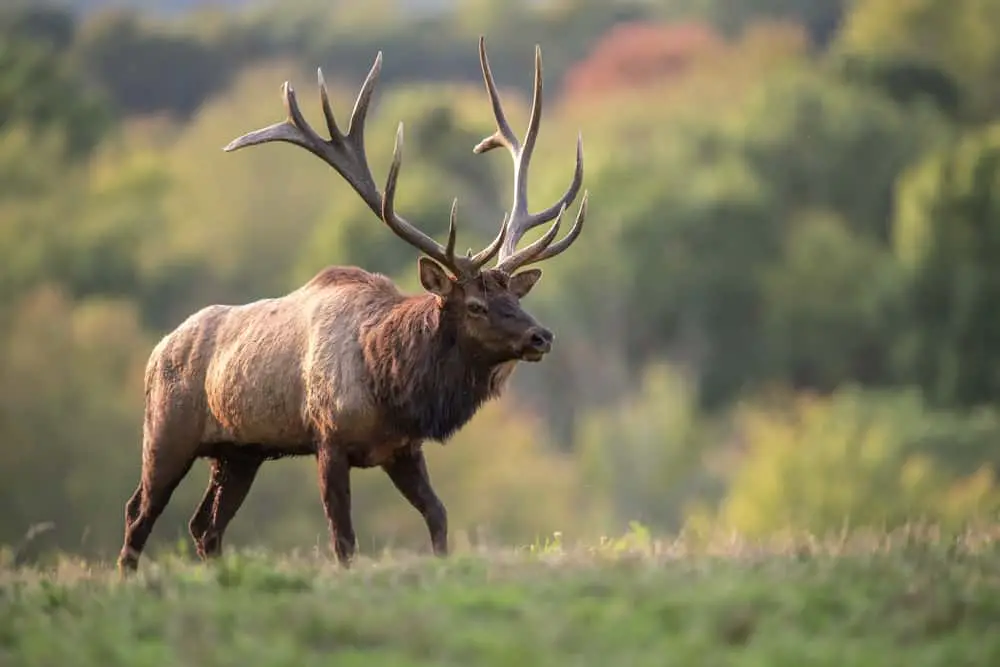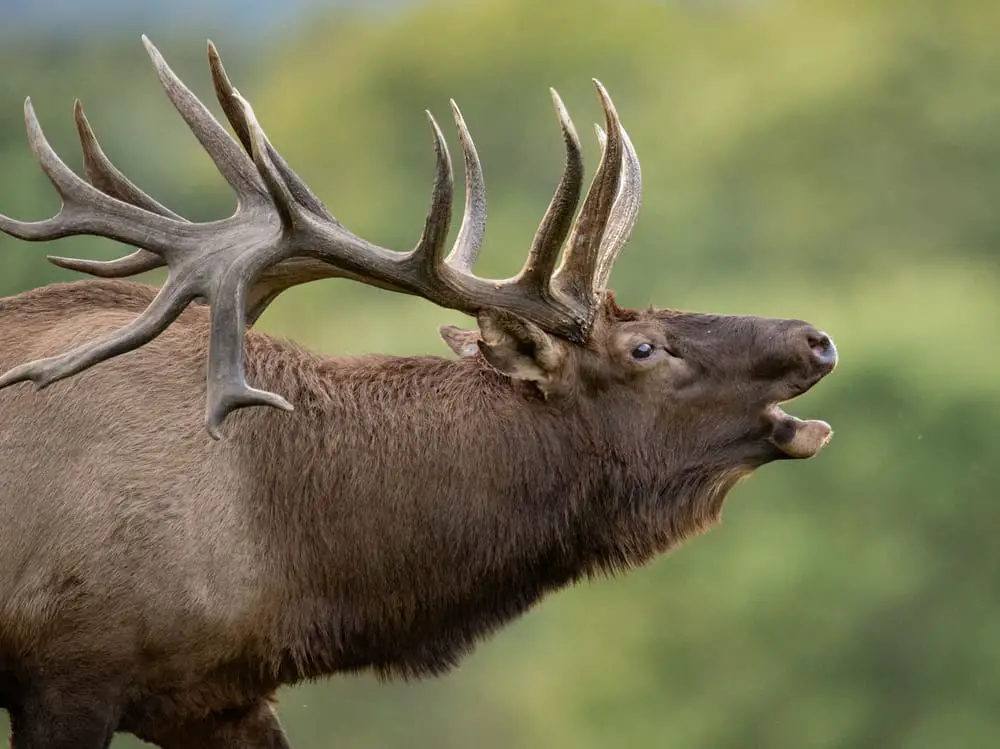Elk are large herbivores that inhabit forested regions of the Northern Hemisphere. Due to their size and impressive antlers, elk have few natural predators. However, they are not invincible and must remain vigilant against potential threats.
Understanding the predator-prey dynamics of these magnificent animals is crucial for conservation efforts and wildlife management. In this article, we will explore the various predators that pose a threat to elk populations and how they impact ecosystem health.
By examining the interactions between elk and their predators, we can gain insights into the intricate balance of nature and develop strategies to protect vulnerable species.

The Role Of Predators In Ecosystems
Keystone species play a significant role in maintaining the balance of ecosystems. They are essential to the functioning and stability of their respective habitats, as they exert a disproportionate influence on other organisms within it.
Predators often fill this keystone role by regulating populations of prey species. By doing so, predators can indirectly affect lower trophic levels through what is known as trophic cascades.
Trophic cascades occur when changes at one level of the food chain have indirect effects throughout the rest of the ecosystem. The loss or addition of a predator can cause ripples that reverberate up and down the food web, affecting everything from primary producers to top-level carnivores.
For example, if a predator such as wolves were removed from an area, deer populations would likely increase due to reduced predation pressure. This could then lead to overgrazing and depletion of vegetation resources for other herbivores, which may result in population declines or shifts in distribution patterns among these animals.
Natural Predators Of Elk
The role of predators in ecosystems is crucial for maintaining a balance between prey and predator populations.
Elk are no exception to this rule, as they too have natural predators that help regulate their population dynamics.
Elk predators include wolves, bears, mountain lions, and coyotes. Each predator has adapted specific hunting strategies to capture elk successfully.
For instance, wolves hunt in packs and target the weakest members of an elk herd; bears rely on their strength to overpower adult elks while mountain lions attack silently from behind.
Coyotes also hunt in groups but mainly target young or weakened elks.
These adaptations allow these predators to sustain themselves by preying upon elk herds while keeping their populations under control.
However, human encroachment into these ecosystems has led to increased pressure on both elk and their predators’ survival rate.
Wolves: A Primary Threat To Elk
Wolf reintroduction has been a controversial topic for decades, with proponents arguing that wolves are an essential part of the ecosystem and opponents claiming they pose a threat to livestock and human safety.
One thing is clear, however – wolves are one of the primary predators of elk, and their presence can have significant impacts on elk populations. Wolves typically hunt in packs, using coordinated tactics to take down prey much larger than any individual wolf could manage alone.
While some may argue that this makes wolves overly efficient at controlling elk populations, others point out that natural predation helps maintain healthy ecosystems by keeping herbivore populations in check. However, it’s worth noting that while wolves do impact elk numbers, other factors such as habitat loss and hunting pressure also play important roles in shaping population dynamics.
Overall, it’s clear that whether you view them as friend or foe, the reintroduction of wolves has had far-reaching consequences for the ecology and management of North American wildlife.
Other Large Carnivores That Prey On Elk
Elks are among the largest members of the deer family and have few natural predators. However, there are some large carnivores that prey on them, particularly in North America.
Grizzly bears and mountain lions are two major predators of elk. These animals primarily hunt calves and weakened adults during winter when food is scarce. Grizzly bears use their powerful jaws to inflict fatal bites, while mountain lions rely on stealth to ambush their prey.
In addition to these top predators, wolves also occasionally prey on elk, but they tend to target smaller individuals rather than full-grown adults. Despite this, elks still have a significant impact on ecosystem dynamics as one of the primary herbivores in areas where they live.
Four interesting facts about elk predation
- The success rate for grizzly bear attacks on adult elks is less than 10%.
- Mountain lions can consume up to 20 pounds of meat per day which may last them three days before needing another kill.
- Wolves often work collaboratively with packs or other predators such as coyotes or black bears when hunting elk.
- Studies show that even the presence of predators can alter an ecosystem’s vegetation growth patterns by affecting how much time elk spend grazing in certain areas due to fear or avoidance behaviors caused by predator activity nearby.
The fact remains that despite being formidable creatures themselves, elks must be vigilant against potential threats from large carnivores like grizzly bears and mountain lions in order to survive in their natural habitats successfully.
Cougars’ Natural Foes: Unmasking Their Predators
Human Impacts On Elk Populations
Other large carnivores that prey on elk are not the only threats to their population. Human-wildlife conflict is a significant issue affecting these animals, particularly in areas where human populations overlap with elk habitats.
The growth of urbanization and industrialization has led to an increase in habitat fragmentation, which limits the available space for wildlife such as elk. As a result, they often end up wandering into residential areas or crossing busy highways, resulting in conflicts with humans.
Hunting regulations have been implemented by various governments worldwide to protect the elk species from overexploitation due to hunting activities. These regulations set quotas on how many elks can be hunted within specific time frames or geographic regions, limiting excessive hunting practices that could threaten their survival.
However, despite these efforts, illegal poaching remains a serious threat to elk populations globally. Poachers hunt these animals primarily for their meat and antlers, which are highly valued commodities in some cultures. Therefore, it is essential to enforce strict monitoring measures and laws against poaching activities to prevent further declines in elk populations due to this illegal practice.
Strategies For Managing Elk And Their Predators
The management of elk populations is a complex task, involving the consideration of various factors such as habitat quality, population densities, and predator-prey dynamics.
Predator control has been an effective strategy in reducing predation on elk herds. The removal or culling of apex predators that prey on elks, such as wolves and cougars, can help reduce the occurrence of depredation events. However, this approach to managing elk populations has faced criticism from conservation groups who advocate for the preservation of natural ecosystems.
Hunting regulations have also been implemented to manage elk populations. These regulations aim to balance hunting pressure with sustainable population levels while ensuring that hunters abide by ethical standards. Hunting seasons are typically set during fall when male elks are in rutting season. This practice ensures that mature males are harvested while allowing females to reproduce uninterrupted. Additionally, hunting licenses are issued based on quotas determined by wildlife managers to avoid overharvesting and maintain healthy population sizes.
Despite its effectiveness, hunting as a management tool has also sparked debate regarding animal welfare concerns and its impact on biodiversity conservation efforts.
Strategies for Managing Elk Populations:
- Predator Control
- Hunting Regulations
- Wildlife Management Quotas
- Habitat Management and Restoration

The Importance Of Conservation Efforts
Strategies for managing elk and their predators have been developed to balance the needs of both wildlife protection and human interests. As mentioned earlier, elk populations are affected by a variety of factors such as habitat loss, hunting practices, climate change, disease outbreaks, and predation. Among these threats, predators play a crucial role in shaping population dynamics.
Several species are known to prey on elk including coyotes, wolves, bears, mountain lions (cougars), and humans. Although predator control has been implemented in some areas to reduce predation rates and protect livestock or game animals from competition with wild ungulates like elk; it is often considered controversial due to ethical concerns and its potential ecological impacts.
Instead of relying solely on lethal measures for controlling predators, conservation techniques such as targeted habitat management or non-lethal deterrents may offer more sustainable solutions that benefit both ecosystems and local communities. By understanding the complex relationships between predators and prey through scientific research and monitoring programs we can develop effective strategies for balancing conservation efforts while promoting coexistence among different animal species.
Conservation efforts must be prioritized to ensure the survival of not only elk but also other wildlife species facing similar threats globally. Protecting natural habitats from fragmentation or degradation caused by anthropogenic activities can help maintain biodiversity hotspots where various plant and animal species coexist. Additionally, reducing poaching incidents or overhunting practices can prevent further declines in endangered populations while supporting ecotourism opportunities that promote economic growth within local communities.
Through collaborative actions focused on preserving our planet’s fragile ecosystems, we can safeguard not only individual species but the entire web of life upon which all living organisms depend for survival.
Conclusion
Predators play a crucial role in maintaining the balance of ecosystems. Elk have several natural predators such as wolves, bears, and cougars that hunt them for food.
Wolves pose the biggest threat to elk populations due to their pack hunting behavior. Human activities such as habitat destruction and hunting have also impacted elk populations.
Efforts are being made to manage elk populations and protect them from predators through conservation initiatives such as increased monitoring and research on predator-prey dynamics. The implementation of measures like controlled hunting seasons has been successful in stabilizing some elk populations while reducing conflict with human interests.
Conservation efforts must continue to ensure that elk populations remain healthy and sustainable in their habitats. However, it is important to consider not just the population size but also the ecological impacts of these majestic creatures on their environment.
Overall, understanding predator-prey relationships is critical in preserving biodiversity and promoting a healthy ecosystem.
